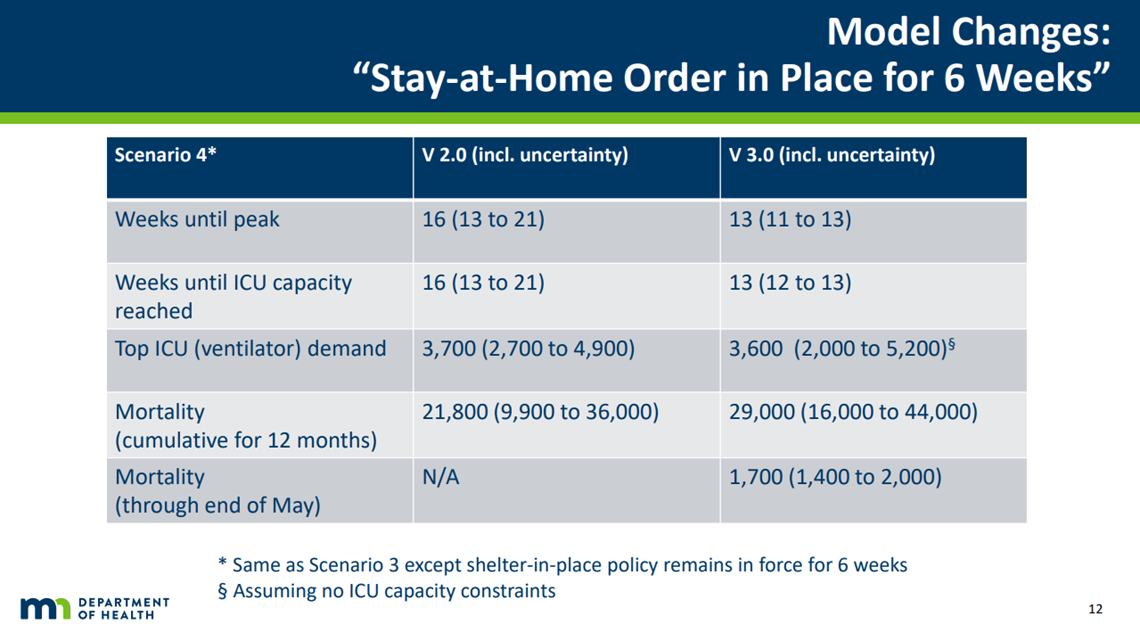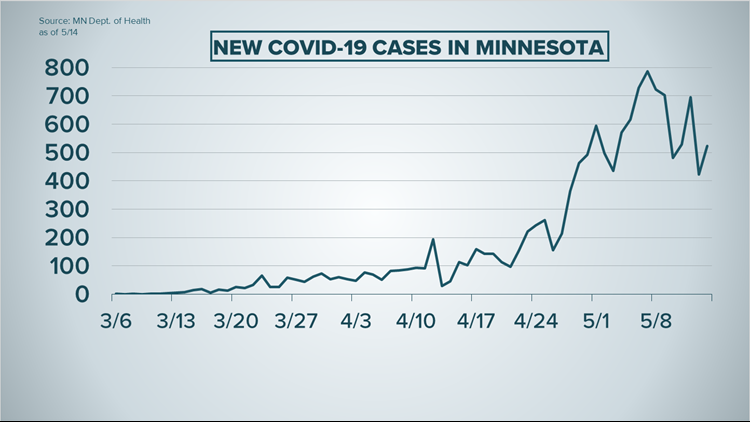ST PAUL, Minn. — Thursday, May 14
- Minnesota's Stay at Home order to expire Sunday at 11:59 p.m., makes way for more lenient Stay Safe order
- Bars, restaurants, salons and barber shops stay closed until at least June 1
- Wis. Governor Tony Evers calls his state "the Wild West" after high court overturns Safer at Home extension
- Minnesota Department of Health releases updated COVID-19 modeling with higher mortality projections
2 p.m.
In their first public address since the governor's announcement that the Stay at Home order will be lifted Monday, the Minnesota Department of Health (MDH) held its daily briefing call Thursday afternoon.
MDH Commissioner Jan Malcolm said the doubling rate of COVID-19 cases has stayed steady at 10 days, despite a higher volume of people being tested in the past 24 hours.
"Anyone who has symptoms of COVID-19 can and should get tested," Malcolm said. "Please do call your provider and see about getting a test. And of course, when people test positive and/or if they feel sick even without a test, please, please self-isolate. That means staying at home."
Malcolm said Minnesotans staying home when sick is a key part of the new Stay Safe MN order that will replace the Stay at Home order. Anyone looking for a testing location near them can utilize the location finder at mn.gov/covid19.
MDH just reached its single-day testing record of 6,717. Public health staff also completed 650 case interviews in a single day, an MDH milestone, Infectious Disease Director Kris Ehresmann said.
Of the people who have died, 98.8% had underlying health conditions. Ehresmann clarified that there is missing information for 164 of the deaths.
The state is expecting a third shipment of remdesivir Friday, according to State Epidemiologist Ruth Lynfield.
Lynfield said the state will be looking at several factors to determine whether the "dial" needs to be turned back and more restrictions need to be put into place once again. Those measures include testing capability, case doubling rate, percent of cases that are considered "community spread," hospitalization and ICU rates, among others.
Malcolm said they have talked about whether it might be possible to enact certain restrictions regionally based on hot spots, instead of doing so on a statewide basis, but there is no firm plan in place right now to do so.
As far as hospital capacity, Malcolm said they continue to work hard on procuring personal protective equipment (PPE).
"The daily monitoring of capacity is really important," she said. A 24-7 resource line is available for providers to report shortages when they come up.
Malcolm said with the new Stay Safe order, groups of under 10 are allowed to gather but should still stay 6 feet apart and wear masks. She said being outside presents a bit more of a "safe zone" as opposed to "confined indoor spaces."
Ehresmann also said "remember that your exit and entrance matter." She said often people will clump together as they're coming and going, even if there is a plan for the gathering itself to implement social distancing.
"We still are really concerned about our elderly and people with underlying conditions and we really do want them to be safe," said Lynfield. "With this virus, it really is a stealth virus, because people can transmit it before they develop symptoms, and some people don't develop symptoms."
Lynfield said they want high-risk people, including the elderly, to continue to stay home. She suggested picking up groceries for elderly neighbors, but refraining from face-to-face interactions.
"This virus has not gone away and it really is up to all of us to do our part to keep transmission down," she said.
11 a.m.
While many residents are eyeing the impending end of Minnesota's Stay at Home order and how it will impact their lives, state health officials are focusing on trends with COVID-19 and signs the virus could be making gains.
The Minnesota Department of Health (MDH) is reporting a single-day high in coronavirus tests performed, with 6,717 in the past 24-hour reporting period. That brings the total number processed in private and state labs to 128,752. The tests done in the past day confirm 523 new cases, bringing the total to 13,435 since the beginning of the pandemic.
An additional 25 Minnesotans died from complications of COVID, bringing the number of fatalities tied to the pandemic to 663. Of those, 537, or 80% occurred in long-term or assisted living facilities. Another nine deaths are being listed as "probable" COVID-19 deaths, meaning that the virus is listed on that person's death certificate but no positive test was ever confirmed.
Hospitalizations remain fairly stable, with MDH reporting 498 people currently being treated on an inpatient basis. Of those patients, 203 have symptoms serious enough to require treatment in the ICU.
Of those diagnosed with the virus, 9,136 have recovered to the point they no longer require isolation.
In response to a question about packed bars in Wisconsin after the state Supreme County struck down Gov. Tony Evers' Safer at Home order, Malcolm said she hopes Minnesotans will continue to practice "aware and considerate" behavior and keep the vulnerable members of the community in mind."We're going to have to do this in a very careful and intentional way," Malcolm said. "We can all contribute to doing this successfully or not."
Hennepin County has by far the largest number of both cases and fatalities, with 4,331 cases diagnosed and 441 deaths. Stearns County has the second most cases with 1,609, followed by Nobles County with 1,319. Both of those counties have been tied to outbreaks at meat processing plants.
Wednesday, May 13
6 p.m.
Gov. Tim Walz announced that Minnesota's Stay at Home will expire Sunday, May 17 at 11:59 p.m.. Gatherings of fewer than 10 will be allowed and some businesses will open at reduced capacity.
The state will transition to a "Stay Safe Minnesota" concept. This means still working from home if possible, wearing masks when shopping and continuing to practice social distancing.
Walz signed an executive order that protects workers who speak out about working conditions if they deem them unsafe.
Walz said he signed another executive order that allows those who are at-risk, have health issues to stay at home.
5 p.m.
Sources who say they were briefed by the governor tell KARE 11 that Governor Tim Walz will allow the current Stay at Home order to expire. Those sources said a new Stay Safe order will take its place, allowing some retail to open, and gatherings of up to 10 people.
11:40 a.m.
Ahead of the governor's announcement on Minnesota's next steps in the response to COVID-19, the state department of health has released updated modeling projections about the virus' spread.
Minnesota Department of Health (MDH) Commissioner Jan Malcolm appeared in a live streamed presentation alongside State Health Economist Stefan Gildemeister at 11 a.m. Wednesday. They presented the latest version of the modeling that is used to help inform decisions by state leaders around the pandemic in Minnesota.
The modeling takes into account different scenarios with different lengths and degrees of social distancing and shelter-in-place restrictions, and then projects ranges of deaths and approximate "peak ICU demand" timelines. MDH has stressed that models are not used to predict exact numbers, but are tools to help them understand which variables are the most important in reducing deaths and delaying the peak of the virus in order to build up hospital capacity.
Gov. Tim Walz first revealed an earlier version of the modeling on April 10. MDH has been promising to release the data publicly once again after they re-run the model with updated information, including the effects of the Stay at Home order that's been in place since March 27.
The new version of the model incorporated five key changes, according to Gildemeister:
- Factored in asymptomatic infections and deaths occurring outside the hospital
- Restricted the ICU demand metric to only ventilated cases, since physicians say that’s what matters most
- Plugged in newly available U.S. data
- Incorporated new calibrated parameters like the proportion of 70+ year olds dying in non-hospital settings, and reduction in contacts under stay-at-home restrictions
- Included real-world Minnesota deaths and hospitalizations through April 25
In general, the new model shows less time to the peak of cases, and some increases in estimates for ICU demand and full-epidemic mortality.
"The general direction we're seeing here is that there's increased mortality by the end of May," Gildemeister said.
Gildemeister said several things factor into the changes:
- They re-calibrated to include rising Minnesota deaths
- Mitigation was less effective than expected, with both initial physical distancing (38% instead of the hoped-for 50%) and the stay at home order (59.5%, not 80%)
- Changes to ICU mortality assumptions and data


11 a.m.
After exceeding 5,000 daily tests for just the second time since the beginning of the COVID-19 pandemic, the Minnesota Department of Health is reporting a dip in test numbers Wednesday.
MDH says 3,517 tests were processed in private and state labs in the past 24-hour reporting period, bringing the total of those tested to 122,035. Those tests confirmed an additional 423 cases of coronavirus, bringing the total number of Minnesotans who have tested positive to 12,917.
As of May 13, MDH is changing the way it is reporting daily case numbers, including reporting of cases based on the date a specimen was collected. That could result in changes in daily case totals as specimen results are received.
COVID-19 has claimed 24 additional lives, increasing the number of fatalities caused by the virus to 638. Health officials say 517 of those deaths occurred in long-term care or assisted living facilities.
As of Wednesday 494 people are being treated for the coronavirus in hospitals across Minnesota. Of those patients 199 are experiencing symptoms serious enough to require treatment in the ICU. MDH says 1,851 Minnesotans have been hospitalized with symptoms of COVID-19 since the pandemic began.
Those diagnosed with the virus continue to recover, with 8,787 positive cases no longer requiring isolation. That number is more than two-thirds, or 68%, of all cases diagnosed.



